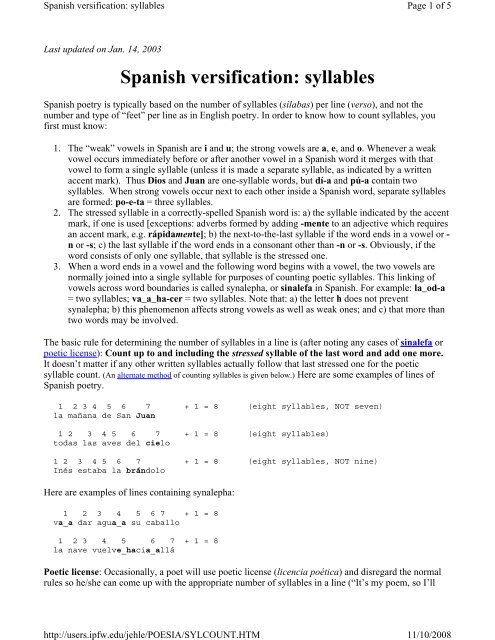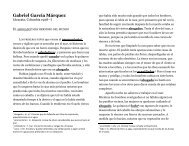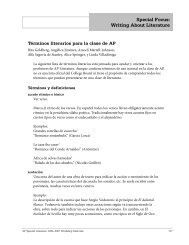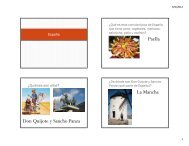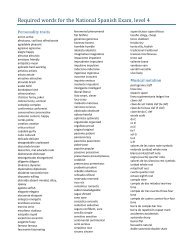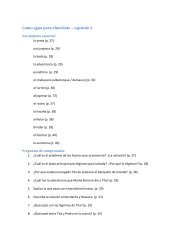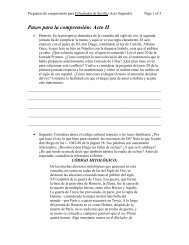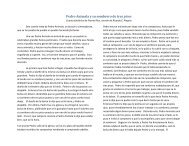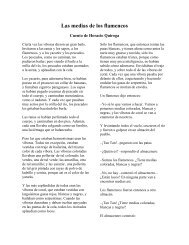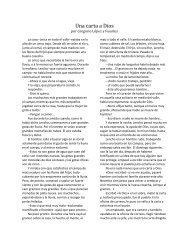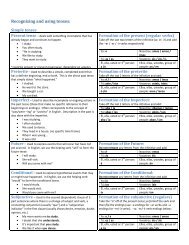Spanish versification: syllables - tatespanish.com
Spanish versification: syllables - tatespanish.com
Spanish versification: syllables - tatespanish.com
You also want an ePaper? Increase the reach of your titles
YUMPU automatically turns print PDFs into web optimized ePapers that Google loves.
<strong>Spanish</strong> <strong>versification</strong>: <strong>syllables</strong><br />
http://users.ipfw.edu/jehle/POESIA/SYLCOUNT.HTM<br />
Page 1 of 5<br />
11/10/2008<br />
Last updated on Jan. 14, 2003<br />
<strong>Spanish</strong> <strong>versification</strong>: <strong>syllables</strong><br />
<strong>Spanish</strong> poetry is typically based on the number of <strong>syllables</strong> (sílabas) per line (verso), and not the<br />
number and type of “feet” per line as in English poetry. In order to know how to count <strong>syllables</strong>, you<br />
first must know:<br />
1. The “weak” vowels in <strong>Spanish</strong> are i and u; the strong vowels are a, e, and o. Whenever a weak<br />
vowel occurs immediately before or after another vowel in a <strong>Spanish</strong> word it merges with that<br />
vowel to form a single syllable (unless it is made a separate syllable, as indicated by a written<br />
accent mark). Thus Dios and Juan are one-syllable words, but dí-a and pú-a contain two<br />
<strong>syllables</strong>. When strong vowels occur next to each other inside a <strong>Spanish</strong> word, separate <strong>syllables</strong><br />
are formed: po-e-ta = three <strong>syllables</strong>.<br />
2. The stressed syllable in a correctly-spelled <strong>Spanish</strong> word is: a) the syllable indicated by the accent<br />
mark, if one is used [exceptions: adverbs formed by adding -mente to an adjective which requires<br />
an accent mark, e.g. rápidamente]; b) the next-to-the-last syllable if the word ends in a vowel or -<br />
n or -s; c) the last syllable if the word ends in a consonant other than -n or -s. Obviously, if the<br />
word consists of only one syllable, that syllable is the stressed one.<br />
3. When a word ends in a vowel and the following word begins with a vowel, the two vowels are<br />
normally joined into a single syllable for purposes of counting poetic <strong>syllables</strong>. This linking of<br />
vowels across word boundaries is called synalepha, or sinalefa in <strong>Spanish</strong>. For example: la_od-a<br />
= two <strong>syllables</strong>; va_a_ha-cer = two <strong>syllables</strong>. Note that: a) the letter h does not prevent<br />
synalepha; b) this phenomenon affects strong vowels as well as weak ones; and c) that more than<br />
two words may be involved.<br />
The basic rule for determining the number of <strong>syllables</strong> in a line is (after noting any cases of sinalefa or<br />
poetic license): Count up to and including the stressed syllable of the last word and add one more.<br />
It doesn’t matter if any other written <strong>syllables</strong> actually follow that last stressed one for the poetic<br />
syllable count. (An alternate method of counting <strong>syllables</strong> is given below.) Here are some examples of lines of<br />
<strong>Spanish</strong> poetry.<br />
1 2 3 4 5 6 7 + 1 = 8 (eight <strong>syllables</strong>, NOT seven)<br />
la mañana de San Juan<br />
1 2 3 4 5 6 7 + 1 = 8 (eight <strong>syllables</strong>)<br />
todas las aves del cielo<br />
1 2 3 4 5 6 7 + 1 = 8 (eight <strong>syllables</strong>, NOT nine)<br />
Inés estaba la brándolo<br />
Here are examples of lines containing synalepha:<br />
1 2 3 4 5 6 7 + 1 = 8<br />
va_a dar agua_a su caballo<br />
1 2 3 4 5 6 7 + 1 = 8<br />
la nave vuelve_hacia_allá<br />
Poetic license: Occasionally, a poet will use poetic license (licencia poética) and disregard the normal<br />
rules so he/she can <strong>com</strong>e up with the appropriate number of <strong>syllables</strong> in a line (“It’s my poem, so I’ll
<strong>Spanish</strong> <strong>versification</strong>: <strong>syllables</strong><br />
http://users.ipfw.edu/jehle/POESIA/SYLCOUNT.HTM<br />
Page 2 of 5<br />
11/10/2008<br />
decide whether or not to follow the rules”). Three examples of poetic license are dieresis, syneresis, and<br />
hiatus:<br />
1. Syneresis (la sinéresis) is the joining of two vowels within a word to form a single syllable<br />
instead of two <strong>syllables</strong>:<br />
1 2 3 4 5 6 7 8 9 10 + 1 = 11<br />
Héroes sin redención y sin historia<br />
(The o and e of “Héroes” are<br />
merged into one syllable<br />
instead of the usual two.)<br />
2. Dieresis (la diéresis) is the separating of two vowels within a word which would normally form<br />
one syllable, a diphthong. Remember that i and u are weak vowels in <strong>Spanish</strong> and normally form<br />
diphthongs when they <strong>com</strong>e in contact with other vowels unless they bear a written accent or<br />
dieresis mark:<br />
1 2 3 4 56 7 8 9 10 + 1 = 11<br />
con su cantar süave no_aprendido<br />
(The u of “suave” is made into<br />
a separate syllable instead of<br />
forming a dipthong with a.)<br />
3. Hiatus (el hiato) is the separating of two vowels at word boundaries which would normally form<br />
one syllable because of synalepha:<br />
1 2 3 4 5 6 7 8 9 10 + 1 = 11<br />
Una | ola tras otra bramadora<br />
(“Una” and “ola” are<br />
separated into four<br />
<strong>syllables</strong> instead of<br />
three: Una_ola.)<br />
Note that the safest way to determine the number of <strong>syllables</strong> in the lines (el cómputo silábico) of a<br />
<strong>Spanish</strong> poem is to pick lines where there is no chance for synalepha, dieresis, syneresis, or hiatus, and<br />
count the number of <strong>syllables</strong> in them.<br />
Special case: Lines with caesura: If a very long line is involved (14 <strong>syllables</strong> or more), it will normally<br />
be divided into two half-lines or hemistiches (hemistiquios), divided by a pause or break called a caesura<br />
(cesura). In this case, to determine the total number of <strong>syllables</strong> for a line, you must count the number of<br />
<strong>syllables</strong> for each hemistich and then add those two numbers together.<br />
1 2 3 4 5 6+1=7 1 2 3 4 5 6+1=7 7 + 7 = 14<br />
nunca_una sola vez, || jamás era_olvidada (14 syl. line)<br />
Most frequently line lengths: In theory, there may be any number of <strong>syllables</strong> per line, as long as it’s<br />
more than one. The most frequently occuring ones are lines of 6, 7, 8, 11, 14, and 16 <strong>syllables</strong>. Except<br />
for modern free verse, all the lines in a poem normally have the same number of <strong>syllables</strong>; however,<br />
some poems may include lines of both 7 and 11 <strong>syllables</strong>.
<strong>Spanish</strong> <strong>versification</strong>: <strong>syllables</strong><br />
http://users.ipfw.edu/jehle/POESIA/SYLCOUNT.HTM<br />
Page 3 of 5<br />
11/10/2008<br />
Practice<br />
Determine the number of <strong>syllables</strong> per line in the following selections. [Answers are given at the bottom<br />
of this page.]<br />
1. From “La mozuela de Bores”, by el Marqués de Santillana:<br />
Señora, pastor<br />
seré si queredes;<br />
mandarme podedes,<br />
<strong>com</strong>o a servidor.<br />
Number of <strong>syllables</strong>: _______<br />
2. From “Soneto X”, by Garcilaso de la Vega<br />
¡Oh dulces prendas por mi mal halladas,<br />
dulces y alegres cuando Dios quería!<br />
Juntas estáis en la memoria mía,<br />
y con ella en mi muerte conjuradas.<br />
Number of <strong>syllables</strong>: _______<br />
3. From “Noche serena”, by Fray Luis de León:<br />
¿Quién es el que esto mira,<br />
y precia la bajeza de la tierra,<br />
y no gime, y suspira<br />
por romper lo que encierra<br />
el alma, y de estos bienes la destierra?<br />
Number of <strong>syllables</strong>: _______<br />
4. From the anonymous “Romance de la mora Moraima”:<br />
Yo me era mora Moraima,<br />
morilla de un bel catar;<br />
cristiano vino a mi puerta,<br />
cuitada, por me engañar.<br />
Hablóme en algarabía<br />
<strong>com</strong>o aquél que la bien sabe.<br />
Number of <strong>syllables</strong>: _______<br />
5. From El libro de buen amor, by Juan Ruiz, el Arcipreste de Hita:<br />
¡Oh María<br />
luz del día<br />
sé mi guía
<strong>Spanish</strong> <strong>versification</strong>: <strong>syllables</strong><br />
http://users.ipfw.edu/jehle/POESIA/SYLCOUNT.HTM<br />
Page 4 of 5<br />
11/10/2008<br />
toda vía.<br />
Number of <strong>syllables</strong>: _______<br />
6. From Los milagros de Nuestra Señora, by Gonzalo de Berceo:<br />
Dieron gracias a Dios de buena voluntad.<br />
a la santa Reína la madre de piedad,<br />
quien hizo tal milagro por su benignidad,<br />
por quien está más firme toda la cristiandad.<br />
Number of <strong>syllables</strong>: _______<br />
7. From “El Cuervo y el Zorro”, by Félix María de Samaniego:<br />
En la rama de un árbol,<br />
bien ufano y contento,<br />
con un queso en el pico,<br />
estaba el señor Cuervo.<br />
Number of <strong>syllables</strong>: _______<br />
8. From El libro de buen amor, by Juan Ruiz, el Arcipreste de Hita:<br />
Todos cuantos en su tiempo en esta tierra nacieron,<br />
en riqueza y cualidades tanto <strong>com</strong>o él no crecieron;<br />
con los locos se hace loco, los cuerdos le enaltecieron,<br />
es manso más que un cordero, pelear nunca le vieron.<br />
Answers<br />
Number of <strong>syllables</strong>: _______<br />
Alternate Method of Counting Syllables<br />
In case you’re interested, here’s the other way of determining how many <strong>syllables</strong> are in a line of<br />
<strong>Spanish</strong> poetry, although it’s a little more <strong>com</strong>plicated to explain. First, you should know some more<br />
terms:<br />
Agudo: A palabra aguda (or a verso agudo) is stressed on the last (última) syllable, for<br />
example habló, reloj, Dios.<br />
Llano: A palabra llana (or a verso llano) is stressed on the next-to-the-last (penúltima)<br />
syllable, for example hablo, cárcel, dioses.<br />
Esdrújulo: A palabra esdrújula (or a verso esdrújulo) is stressed on the third-from-thelast<br />
syllable, for example hablándome, propósito, and the word esdrújulo itself.
<strong>Spanish</strong> <strong>versification</strong>: <strong>syllables</strong><br />
http://users.ipfw.edu/jehle/POESIA/SYLCOUNT.HTM<br />
Page 5 of 5<br />
11/10/2008<br />
Sobresdrújulo: A palabra sobresdrújula (or a verso sobresdrújulo) is stressed on the<br />
fourth-from-the-last syllable, for example diciéndomelo, páguenselas. [This is extremely<br />
rare at the end of a verse, but it is possible.]<br />
The alternate rule for determining the number of <strong>syllables</strong> in a line is (after noting any cases of sinalefa<br />
or poetic license): Count all the <strong>syllables</strong> in the line and add one if the verse is agudo, or subtract<br />
one if the verse is esdrújulo (or subtract two if the verse is sobresdrújulo). If the verse is llano, you<br />
don’t add or subtract anything to the count. Here are the same examples given above for the simpler<br />
rule:<br />
1 2 3 4 5 6 7 + 1 = 8 (add one to a verso agudo)<br />
la mañana de San Juan<br />
1 2 3 4 5 6 7 8 = 8 (verso llano)<br />
todas las aves del cielo<br />
1 2 3 4 5 6 7 8 9 - 1 = 8 (subtract one from a verso esdrújulo)<br />
Inés estaba la brándolo<br />
Answers for the practice:. 1: 6. 2: 11. 3: 7 and 11. 4: 8. 5: 4. 6: 14 (7+7). 7: 7. 8: 16 (8+8)<br />
Volver a Antología de poesía española home page.<br />
Texto por Fred F. Jehle <br />
URL: http://users.ipfw.edu/jehle/poesia/sylcount.htm


